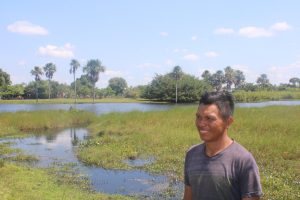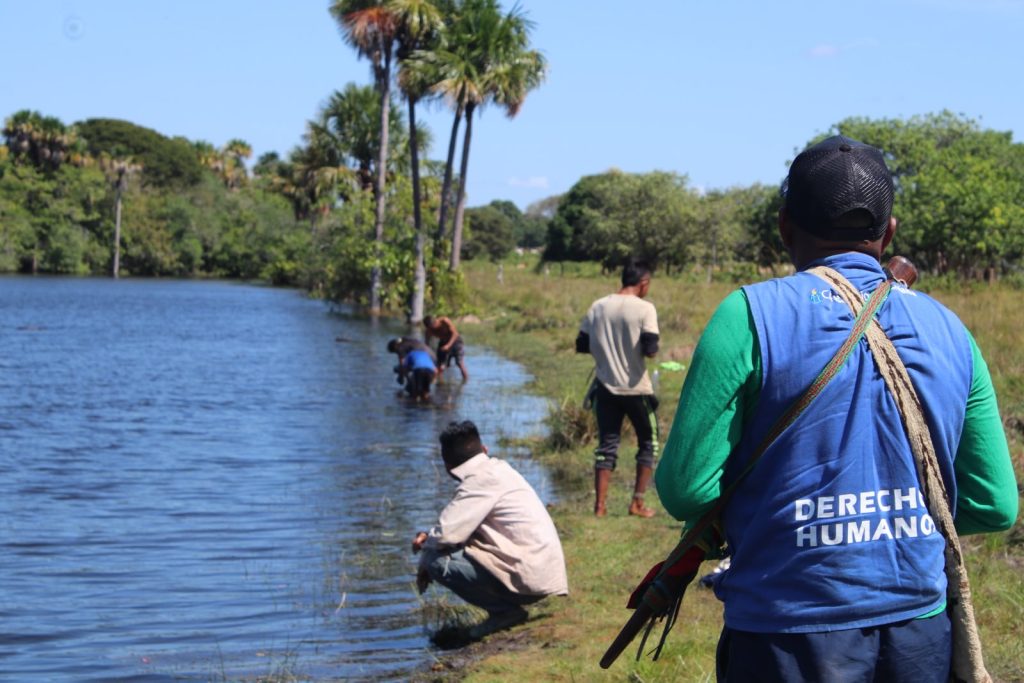Interview: The Wajtakju Namto Ponötsi walk– the importance of a cultural practice
The Wajtakju Namto Ponötsi ancestral walk is a practice that the Maiben Masiware community carry out. They are a nomadic indigenous community living in the Caño Mochuelo reservation, located between the municipalities of Paz de Ariporo and Hato Corozal, in the region of Casanare. The millennial old tradition allows them to reconnect with their roots by visiting their sacred sites. The Corporación Claretiana Norman Pérez Bello (CCNPB) has been accompanying the walk for several years, in an effort to visibilise, senisitise and show solidarity and support. In this interview, Luis Fernando Tobu and Andrés Tiboche share their perspectives on the importance of this cultural heritage, essential to Colombia’s diversity and national identity, the severe threats it faces today and the calls to guarantee dignified conditions to continue practice.
Luis Fernando Tobu (LT) is a member of the Maiben Masiware community. His life has been marked by forced recruitment at the age of 15, but when he returned to his community, he took on a prominent role as a leader in the organisational processes of the Caño Mochuelo reservation.
Andrés Tiboche (AT) is a human rights defender and legal professional with fifteen years of experience in community work, ten years in environmental defence and three years of experience with indigenous communities, specifically in the Caño Mochuelo reservation where he works with the Claretian Corporation Norman Pérez Bello.
-Describe the cultural practice of this ancestral walk and its significance for the Maiben Masiware community?
LT: The walk is a traditional practice since the creation of our God Namon. It is very important to reaffirm that we are originally from this land; the Orinoquia. We inherited it from our ancestors, who left us an unforgettable history of struggle and resistance in our ancestral territory.
We practice it in order to strengthen our spiritual ties and to raise awareness of the sacred sites that are of the greatest significance to us. Dancing and telling stories between generations is also part of the practice. We do not write things down, instead everything is based on oral traditions, which is why we recognise the importance of sharing so that new generations do not lose these customs and the ancestral traditions.
The walk is led by the elders, as they are the pioneers, and we hunt the wild animals needed to sustain us. The way back from Paz de Ariporo to the reserve is usually more complicated because the weather conditions are harsh: water and food are very scarce.
AT: The walk is a route that the Maiben Masiware community do each year to their sacred sites around the Ariporo River. These sites are grounds for hunting and gathering, but also places where there have been massacres and where the community have buried their dead. An average of 350 people – a number that has increased in 2024, including everyone from the youngest, to pregnant women, to the eldest, participate. The walk there is approximately 200 kilometres, from the Caño Mochuelo reserve to the municipality of Paz de Ariporo, and takes between 6 and 11 days. The walk back is much more complicated for the nomadic people, especially for the most vulnerable. It is a transition from rural to urban, from savannah to river embankment, passing through private properties where hunting and gathering is often not allowed.
This entire region of the Llanos Orientales and the Orinoco is home to communities that live through rain periods that flood the savannah, as well as the summer where it dries up, something that is often forgotten. It should be remembered that this world still survives despite the history of displacement and massacres in the region.
– What risks and threats have the ancestral walk faced, and what is it like today? And how does that impact the ancestral practice and the community´s means of relating to their territory?

Luis Fernando Tobu
LT: Originally, the walk was carried out by travelling on the river but, due to the presence and movements of paramilitary groups through our ancestral territories and the threats we received, we were forced to abandon this practice. Since 2004, we have carried it out on land.
Today, as a result of multiple complaints from farmers (and landowners), there have been restrictions put in place by illegal armed groups. It is a very strong threat, not just in the here and now, but over time for the generations to come, because this cultural tradition could possibly be lost due to the lack of access to the territories where our ancestors lived.
AT: In 2008, the Maiben Masiware were once again threatened by the presence of paramilitary groups in an area that are part of the traditional route of the walk. This forced them to change the route and stop passing through the area, affecting their freedom of movement through the territory. More recently, in 2024, dissidents of the FARC imposed limitations on hunting. In general, there is a strong conflict between the community and the settlers and others in the area, due to the hunting of cattle or pigs. The CCNPB began to accompany the Maiben Masiware community in a more visible way and with more support from both institutions and communities to give them the confidence to continue their cultural practice in the presence of these various armed groups, such as the ELN, dissidents and paramilitaries.
– Why do you think it is important to make this ancestral practice visible at the national and international level?
LT: We want the ancestral walk to have a global impact, to be recognised as important and for this tradition to be protected, along with the places where we always do it and the stories that go with it. It is a way of demonstrating the importance of continuing to carry out their ancestral cultural practices.
AT: It is vital to see this practice as an Intangible Cultural Heritage, but also as part of the Colombian identity itself, as it is part of a history that still seems a little unknown. There is a historical debt to these communities, especially in this case the Maiben Masiware.
On an international level, I think it is very important to remember that there are still nomadic peoples. It allows us to understand other ways of seeing the world, which from an outsider’s point of view may seem strange. That is what plurality and cultural diversity are all about. You are enriched through the experience of others, and this can be seen in places where it is really practiced. It is very valuable to be able to say, “in the Colombian Orinoco we continue to walk through our ancestral territories”. It goes against the tendency towards homogenisation that sometimes arises from a position of power. There are many historical events that we have forgotten as a nation, and thinking about the construction of identity it is also important to recover the memory in other ways.
